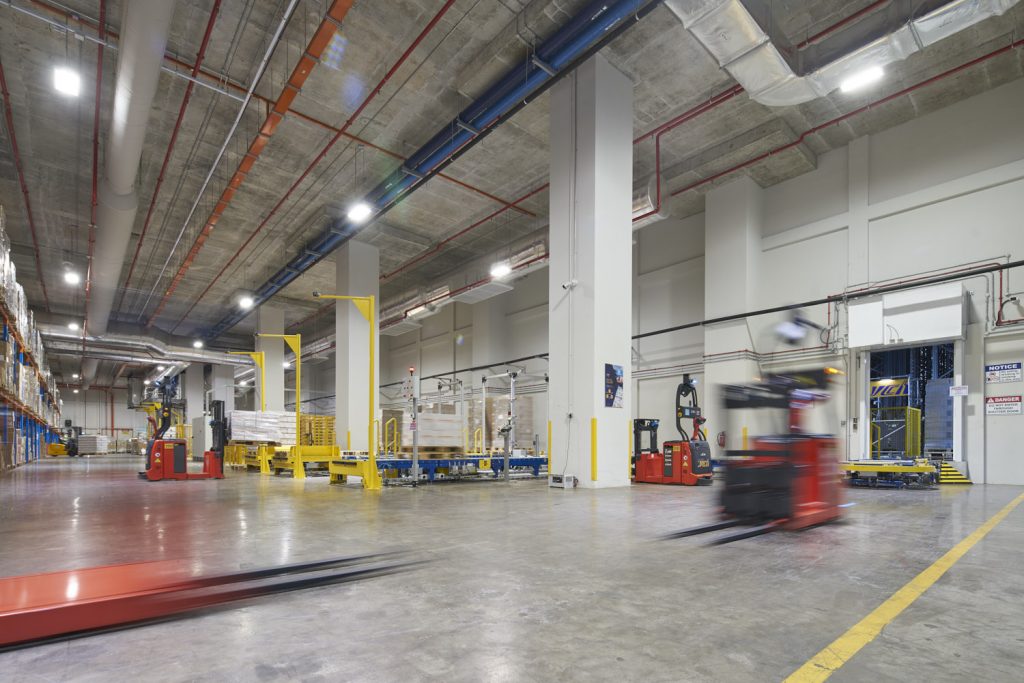

Technologies like AI, data analytics, IoT and blockchain are pushing the boundaries of what supply chain and logistics companies can do to significantly improve their operations. As supply chain management continues to increase in complexity, more industry players will depend on new technologies to better understand where their business stands.
Singapore-based YCH Group knows its business and is putting innovation at the heart of its development and growth. Located at Supply Chain City, dubbed Asia’s supply chain nerve centre, the homegrown company works with suppliers, manufacturers, brands, resellers and consumers to manage each stage of the supply chain—a ‘7PL’ approach so to speak—through inventive use of technology and the fast evolvement of work processes.
Combining digital and infrastructure
The Fusionaris system serves as a key infrastructure for YCH’s operations. This facility combines five stories of warehouse space and an automated storage and retrieval system that allows 66,000 pallets and round-the-clock supply chain activity with 18 cranes in operation. A series of mezzanines with pallet conveyors for inbound and outbound cargo connects to four floors, where case and piece picking with other value-added services are undertaken.
“Leveraging physical infrastructures with digital capabilities can yield powerful results, allowing logistics players to move their cargoes quickly, safely, and efficiently at lower costs and maximum efficiency,” said Ryan Yap, head of growth, innovation and partnerships at YCH Group.
“New tech such as supply chain analytics help businesses by offering insights on people, processes, assets and the entire value chain to facilitate quicker decisions for global supply chain management. Solutions such as order and inventory optimisation also help them to position the right stocks for the right orders across different countries by optimising the inventory,” he added.
‘SuperPort’ concept
This infrastructure and technological acumen has certainly not gone unnoticed. In March, the company was selected to design, develop, and operate a logistics complex in Phnom Penh (PPLC), predicted on its ‘superport’ concept. The facility will feature the use of logistics technology to improve resilience, visibility and process flow, as well as a training academy to develop Cambodia’s local human capital in the logistics sector.
Yap added that the concept will show the advantages of multimodal transportation through road, rail, air and sea linkages, acting as a supply hub for manufacturing operations, particularly in fast-developing countries in the region like Cambodia and Vietnam.
“The idea of SuperPort is to create a smart logistics infrastructure so that each country can grow and move up the value chain, in turn creating a formidable economic bloc in ASEAN as a region,” noted Yap.
Innovating to adapt
When the pandemic hit supply chains and businesses in the region, this spurred an even bigger need to ensure business continuity. YCH said it spent significant resources to provide medical supplies and assistance for its employees when the situation took a turn for the worse.
With stricter controls on the movement of people and goods, Yap said supply chain traceability and control had significantly increased, creating a learning curve and necessitating an efficiency trade-off. “Fortunately, our experience in supply chain management allowed us to take measures to ensure that the disruption to our operations remains minimal, though it was admittedly difficult to minimise any increase in costs,” he noted.
“Nevertheless, such measures will surely impact the global economy moving forward and we have chosen to see them as a new avenue where we must continuously innovate and augment our supply chain capabilities with new solutions that would aid in restoring and preserving pre-pandemic efficiency levels,” he added.
For BCP purposes, the Singapore team had to segregate and map out individual functions, assign dedicated manpower to cover those functions, plan shift patterns to allow different shifts to function as potential back-ups in case of an outbreak, and re-plan overlapping functions to ensure social distancing whilst preserving smooth hand-overs.
‘While it has certainly not been easy to maintain high productivity with these measures, we are proud to say that our operations team have stood united and open minded to being re-trained to ensure everyone stays safe,” Yap said.
Regional integration
Despite the crisis, growing calls for regionalisation are taking place, YCH noted, with Asia in the middle of two mega-regional trade agreements. Its homebase Singapore, for instance, is actively participating in both the CPTPP and RCEP as it looks to mitigate the negative impact of Covid-19 and maintain open supply chains.
There has also been an increase in trade corridors with major hubs like China, which has been the ASEAN’s largest trading partner for 12 consecutive years. Meanwhile, growing confidence in India’s growing manufacturing capacity and the region’s rising services exports, including travel, transport and business services, offers much promise.
With the growth continuing in these three markets, YCH said it is constantly reinventing its solutions to drive ‘unparalleled omni-channel fulfilment,’ which has bode well for the company in tapping new markets, opportunities, and supply chain methodologies.
“Such an approach encapsulates the idea of having multiple sites of operation that are flexible, scalable, and most importantly, connected to each other to ensure a robust supply chain. This will be the key to supply chain continuity which will surely be on the forefront of everyone’s minds moving forward,” said Yap.
Industry ecosystem
Whilst technology is an enabling tool for innovation, YCH says that having an ecosystem inspires critical innovation, and this is more prevalent at Singapore’s ‘supply chain nerve centre’. With its knowledge-based LEARN ecosystem, Supply Chain City is designed to stimulate innovation through collaboration. Its hub approach gives smaller players a chance to be part of an integrated ecosystem, providing access to opportunities across the value chain and bringing inclusive and sustainable growth for supply chain partners.
“This forms the objective of our smart logistics infrastructure project. We are not here just to build a smart infrastructure, stay for a couple of years, and then cash out. Our goal is a long term one with the idea of creating a symbiotic partnership with the local country to ensure the continued success of the SuperPort project and facilitate regional and subregional trade integration. It is also important for us to grow as a pack, to share our best practices and to innovate together so that we can capture the great opportunities generated from the burgeoning ASEAN economy,” Yap ended.










